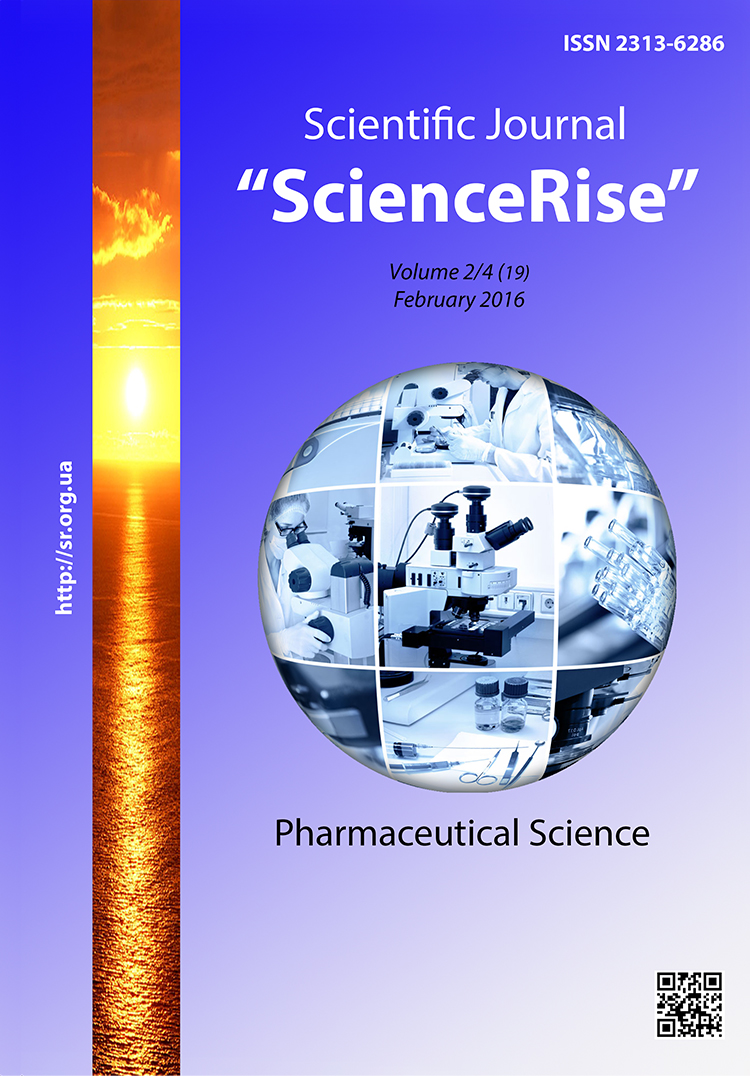Разработка методики контроля сопутствующих примесей в субстанции 7-(4-фтор-бензил)-3-тиоксо-2,3-дигидро[1,2,4]триазоло[4,3-а]пиразин-8(7Н)-она
DOI :
https://doi.org/10.15587/2313-8416.2016.61864Mots-clés :
[1, 2, 4]триазоло[4, 3-а]пиразин, сопутствующие примеси, метод высокоэффективной жидкостной хроматографии, валидационные критерииRésumé
Контроль чистоты субстанций для фармацевтического применения является необходимой частью современных требований к субстанциям на стадии фармацевтической разработки.
Цель. Целью работы была разработка и валидация методики определения сопутствующих примесей в новой субстанции 7-(4-фторбензил)-3-тиоксо-2,3-дигидро[1,2,4]-триазоло[4,3-а]пиразин-8(7Н)-она методом высокоэффективной жидкостной хроматографии (ВЭЖХ).
Методы. Среди фармакопейных методов анализа был выбран метод ВЭЖХ, как наиболее чувствительный и селективный инструментальный метод анализа, который позволяет контролировать сопутствующие примеси в данной субстанции.
Результаты. Разработана методика определения сопутствующих примесей новой субстанции 7-(4-фторбензил)-3-тиоксо-2,3-дигидро[1,2,4]-триазоло[4,3-а]пиразин-8(7Н)-она. Определены валидационные характеристики и экспериментально подтверждено их соответствие необходимым критериям приемлемости.
Выводы. Результаты проведенных исследований свидетельствуют о том, что разработанная методика соответствует современным требованиям к аналитическим методикам на предельное содержание примесей и позволяет однозначно характеризовать содержание примесей в новом АФИ
Références
Ajani, O. O., Nwinyi, O. C. (2009). Synthesis and evaluation of antimicrobial activity of phenyl- and furan-2-yl[1,2,4]triazolo[4,3-a]quinoxalin-4(5H)-one and their hydrazone precursors. Canadian Journal of Pure & Applied Sciences, 3 (3), 983–992. Available at: http://eprints.covenantuniversity.edu.ng/98/1/Ajani-Nwinyi_CJPAS.pdf
Labroli, M., Czarniecki, M. F., Poker, C. S. (2011). Pat. US 2013/0196986 A1 Triazolopyrazinones as P2X7 receptor antagonists. № EP2619204 A4; st. 16.09.2011; app. 29.09.2014.
Taher, А., Khalil, N. A., Ahmed, E. M. (2009). Synthesis of certain 1,2,4-triazolo[4,3-a]quinoxalinone derivatives for evaluation of in vitro antitumor and antimicrobial activities. Bulletin of the Faculty of Pharmacy (Cairo University), 1 (47), 19–26.
Krishnan, V. S. H. et. al (1994). Reaction of 3-hydrazinoquinoxalin-2(1H)-one with aromatic/heteroaromatic carboxylic acids using diphenylphosphoryl azide: synthesis and antiallergic activity of s-triazolo[4,3-a]quinoxalin-4-ones. Indian Journal of Heterocyclic Chemistry, 3 (4), 227–232.
Timofeevski, S. L., McTigue, M. A., Ryan, K., Cui, J., Zou, H. Y., Zhu, J. X. et. al (2009). Enzymatic Characterization of c-Met Receptor Tyrosine Kinase Oncogenic Mutants and Kinetic Studies with Aminopyridine and Triazolopyrazine Inhibitors. Biochemistry, 48 (23), 5339–5349. doi: 10.1021/bi900438w
Derzhavna Farmakopeja Ukrai'ny. Vol. 1 (2015). Kharkiv: DP «Ukrai'ns'kyj naukovyj farmakopejnyj centr jakosti likars'kyh zasobiv», 1130.
Solovova, N. V., Kurbatova, S. V., Belousova, Z. P., Osokin, D. M. (2002). Zhidkostnaja hromatografija nekotoryh proizvodnyh pjatichlennyh geterociklov. Vestnik SamGU – Estestvennonauchnaja serija, 4 (26), 113–119.
Komissarova, N. V., Bulanova, A. V., Purygin, P. P. et. al (2008). Izuchenie hromatograficheskogo povedenija nekotoryh azolov v uslovijah vysokojeffektivnoj zhidkostnoj hromatografii. Sorbcionnye i hromatograficheskie processy, 8 (6), 964–970. Available at: http://www.sorpchrom.vsu.ru/articles/20080611.pdf
Poljakova, Ju. L., Bulanova, A. V., Egorova, K. V. et. al (2000). Svjaz' jenergeticheskih harakteristik i indeksa Randicha imidazola i nekotoryh azolidov sul'fokislot s hromatograficheskim uderzhivaniem. Izvestija RAN. Ser. Him, 8, 1401–1404.
Gryzodub, O. I., Leont'jev, D. A., Docenko, T. M. et. al (2004). Standartyzovana procedura validacii' metodyk kil'kisnogo vyznachennja likars'kyh zasobiv metodom standartu. Farmakom, 3, 3–17.
Téléchargements
Publié-e
Numéro
Rubrique
Licence
(c) Tous droits réservés Кристина Юрьевна Нетёсова, Светлана Николаевна Губарь, Ирина Александровна Журавель 2016

Cette œuvre est sous licence Creative Commons Attribution 4.0 International.
Our journal abides by the Creative Commons CC BY copyright rights and permissions for open access journals.
Authors, who are published in this journal, agree to the following conditions:
1. The authors reserve the right to authorship of the work and pass the first publication right of this work to the journal under the terms of a Creative Commons CC BY, which allows others to freely distribute the published research with the obligatory reference to the authors of the original work and the first publication of the work in this journal.
2. The authors have the right to conclude separate supplement agreements that relate to non-exclusive work distribution in the form in which it has been published by the journal (for example, to upload the work to the online storage of the journal or publish it as part of a monograph), provided that the reference to the first publication of the work in this journal is included.

